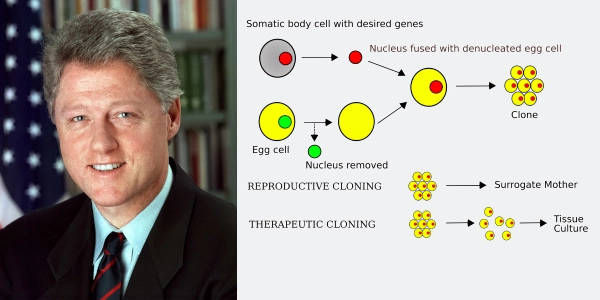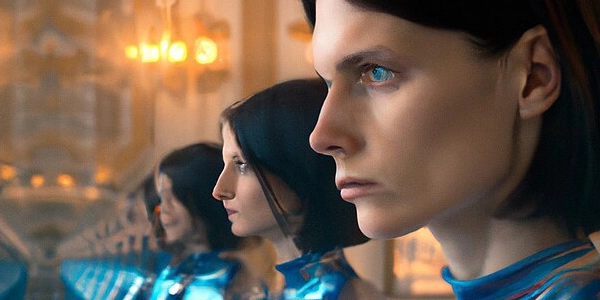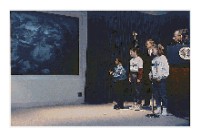-
Timeline - The 1990s
A presidential scandal amidst prosperity and a world that is beginning to show signs of the conflicts to come with the first Gulf War and attacks in New York City.
More 1900s

President Clinton and Boris Yeltsin. Courtesy National Archives.
ABH Travel Tip

If you've never been there, or it's been awhile since you've taken a trip to Washington, D.C., the nation's capitol is a treat for anyone interested in the USA and its history. From the spectacular museums of the Smithsonian, to the recent addition of the Holocaust museum and the Newseum, too, there's so much to see and do. One of the best new attractions is the World War II Memorial. It will make you wonder what took them so long and just why there was any controversy about adding this museum to the space between the Washington Memorial and the Lincoln Memorial.
Click here to Sponsor the page and how to reserve your ad.
-
Timeline
1997 - Detail
March 4, 1997 - Federal funding for any research into human cloning is barred by President Bill Clinton.

They were already working on cloning cows and sheep and other mammals, without asking them about it, or knowing the consequences. So the topic of human cloning was becoming a hot subject in scientific circles, and as we all know through history, if scientists think of something, they will work toward making it happen. Even in 1997, it was unknown whether a cloned human being existed somewhere, whether it be in the United States, China, or another nation. For all we know, your son-in-law in an imperfect clone of Mao Zedong.
But let's look into the serious side of this equation, and what prompted President William Jefferson Clinton to dive into the subject with enough concern to ban its existence, as much as he could. This debate had started in July 1996, when the scientific community, the Roslin Institute, admitted that they had successfully cloned a sheep named Dolly. It had taken 277 attempts to create one live lamb.
President Clinton would issue an executive order banning human cloning research, and establishing a commission, on that March 4, 1997, date, stating ...
"Science often moves faster than our ability to understand its implications. That is why we have a responsibility to move with caution and care, to harness the emerging technology. There is much about cloning that we still do not know. But this much we do know: Any discovery that touches upon human creation is not simply a matter of scientific inquiry, it is a matter of morality and spirituality as well. ... My own view is that human cloning would have to raise deep concerns, given our most cherished concepts of faith and humanity. Each human life is unique, born of a miracle that reaches beyond laboratory science. I believe we must respect this profound gift and resist the temptation to replicate ourselves. At the very least, however, we should all agree that we need a better understanding of the scope and implications of this most recent breakthrough."
Clinton would propose the "Cloning Prohibition Act," which would have been a ban on human cloning research while the ethical and scientific ramifications were studied. It was a five year ban, with the findings allowing for a continued ban for additional years.
However, there were problems from the start. Not the least of which was whether others nations would agree. For some, they had already agreed to ban the practice; others had not. While the initial bill proposed by Representative Vernon Ehlers of Michigan in the House of Representatives near that initial March date banned the research into human cloning by Federal or Private funds. That bill never came up for a vote, even though it had forty-six co-sponsors.
On June 9, 1997, President Clinton had been given a report by the National Bioethics Advisory Commission, and submitted the "Cloning Prohibition Act of 1997" to Congress. The commission had agreed with Clinton's initial response by stating that it was morally unacceptable to create a child using the techniques used to create Dolly. They were clear to state that allowing research into cloning for advancement in medicine would not be affected, as well as some agricultural uses.
However, as of 2018, despite many efforts in the United States Senate and House of Representatives, no bill has been passed by both houses and signed into law. It is a "polite" agreement not to pursue controlled by the Food and Drug Administration. Despite no Federal legislation, a good number of states have tackled the issue and passed legislation banning the practice.
Activity Since 2018
The National Academies of Sciences, Engineering, and Medicine has introduced a 2021 report that focused on the risks of cloning, whether animal or human, citing developmental abnormalities, long-term health issues, as well as the low success rates of the technique. Today, the Food and Drug Administration in the United States does allow cloning in livestock to promote food production. They say it is safe. To us, this is a faulty premise. There is not enough practical data to establish the health concerns to humans of that food; how many items through the centuries have been promoted as safe, just to find out decades later that they have serious health consequences. Yes, that last steak you ate might have been cloned.
It has been stated that human cloning is basically banned through the Dickey-Wicker Amendment, which stops federal funding for reserach using human embryos. However, that seems far from effective. It is a rider attached to appropriation bills since 1995, one year prior to Dolly. There is a consensus that there are no verified human clones. Do we really know what Dr. Mengala is doing?
For its part, the United Nations has adopted a 2005 Declaration on Human Cloning, which includes a universal ban on the practice, under the rationale, rightly so, over human dignity and abuses that could occur. However, it is non-binding. Way to go!

Initial Bill, Cloning Prohibition Act
105th CONGRESS, 1st Session, H. R. 923.
To prohibit the cloning of humans.
IN THE HOUSE OF REPRESENTATIVES, March 5, 1997
Mr. Ehlers introduced the following bill; which was referred to the
Committee on Commerce
A BILL To prohibit the cloning of humans.
Be it enacted by the Senate and House of Representatives of the
United States of America in Congress assembled,
SECTION 1. SHORT TITLE. This Act may be cited as the "Human Cloning Prohibition Act".
SEC. 2. PROHIBITION AGAINST CLONING OF HUMANS.
(a) In General.--It shall be unlawful for any person to use a human
somatic cell for the process of producing a human clone.
(b) Civil Money Penalty.--Any person who violates subsection (a) is
liable to the United States for a civil money penalty in an amount not
exceeding $5,000.
Dickey-Wicker Amendment, Cloning 1995
SEC. 509. (a) None of the funds made available in this Act may be used for --
(1) the creation of a human embryo or embryos for research purposes; or (2) research in which a human embryo or embryos are destroyed, discarded, or knowingly subjected to risk of injury or death greater than that allowed for research on fetuses in utero under 45 CFR 46.208(a)(2) and Section 498(b) of the Public Health Service Act [1](42 U.S.C. 289g(b)) (Title 42, Section 289g(b), United States Code).
(b) For purposes of this section, the term "human embryo or embryos" includes any organism, not protected as a human subject under 45 CFR 46 (the Human Subject Protection regulations) ... that is derived by fertilization, parthenogenesis, cloning, or any other means from one or more human gametes (sperm or egg) or human diploid cells (cells that have two sets of chromosomes, such as somatic cells).
Photo above: Montage (left) President William Clinton, Official Portrait, 1993, Bob McNeely. Courtesy Wikipedia Commons; (right) diagram of somatic cell nuclear transfer, 2007, Quelle: Zeichner: Schorschski / Dr. Jurgen Groth. Courtesy Wikipedia Commons C.C. 3.0. Photo below: Depiction of Human Maid Clones, Encik Tekateki. Courtesy Wikipedia Commons C.C. 4.0. Info source: "Clinton Rejects Support for Human Cloning," 2023, Jane L. Ball, ebsco.com; Clinton White House Archives; "Clinton Bans U.S. Funds for Human Cloning Reseach," Marlene Cimons and Jonathan Peterson, March 5, 1997, Los Angeles Times; Congress.gov; Govtrack.us; "The Law and Human Cloning," 2018, Raj D. Pai and Jason J. Jardine, knobbe.com; "Cloning Laws: Current Framework and Global Oversight," 2025, biologyinsights.com; "Are There Any Human Clones," wellwisp.com; Wikipedia Commons.

History
Photo Bomb

Christopher Columbus, by Ridalfo Ghirlandaio, 1520. New U.S.
preserve, Salt River Bay, on land Columbus actually visited dedicated in the Virgin Islands. Courtesy Wikipedia Commons.
ABH Travel Tip

If you've never been there, or it's been awhile since you've taken a trip to Washington, D.C., the nation's capitol is a treat for anyone interested in the USA and its history. From the spectacular museums of the Smithsonian, to the recent addition of the Holocaust museum and the Newseum, too, there's so much to see and do. One of the best new attractions is the World War II Memorial. It will make you wonder what took them so long and just why there was any controversy about adding this museum to the space between the Washington Memorial and the Lincoln Memorial.
(b) For purposes of this section, the term "human embryo or embryos" includes any organism, not protected as a human subject under 45 CFR 46 (the Human Subject Protection regulations) ... that is derived by fertilization, parthenogenesis, cloning, or any other means from one or more human gametes (sperm or egg) or human diploid cells (cells that have two sets of chromosomes, such as somatic cells).
Photo above: Montage (left) President William Clinton, Official Portrait, 1993, Bob McNeely. Courtesy Wikipedia Commons; (right) diagram of somatic cell nuclear transfer, 2007, Quelle: Zeichner: Schorschski / Dr. Jurgen Groth. Courtesy Wikipedia Commons C.C. 3.0. Photo below: Depiction of Human Maid Clones, Encik Tekateki. Courtesy Wikipedia Commons C.C. 4.0. Info source: "Clinton Rejects Support for Human Cloning," 2023, Jane L. Ball, ebsco.com; Clinton White House Archives; "Clinton Bans U.S. Funds for Human Cloning Reseach," Marlene Cimons and Jonathan Peterson, March 5, 1997, Los Angeles Times; Congress.gov; Govtrack.us; "The Law and Human Cloning," 2018, Raj D. Pai and Jason J. Jardine, knobbe.com; "Cloning Laws: Current Framework and Global Oversight," 2025, biologyinsights.com; "Are There Any Human Clones," wellwisp.com; Wikipedia Commons.

History Photo Bomb

Christopher Columbus, by Ridalfo Ghirlandaio, 1520. New U.S.
preserve, Salt River Bay, on land Columbus actually visited dedicated in the Virgin Islands. Courtesy Wikipedia Commons.
ABH Travel Tip

If you've never been there, or it's been awhile since you've taken a trip to Washington, D.C., the nation's capitol is a treat for anyone interested in the USA and its history. From the spectacular museums of the Smithsonian, to the recent addition of the Holocaust museum and the Newseum, too, there's so much to see and do. One of the best new attractions is the World War II Memorial. It will make you wonder what took them so long and just why there was any controversy about adding this museum to the space between the Washington Memorial and the Lincoln Memorial.
About
America's Best History where we take a look at the timeline of American History and the historic sites and national parks that hold that history within their lands.
Photos courtesy of the Library of Congress, National Archives, National Park Service, americasbesthistory.com & its licensors.
- Contact Us
- About
- © 2025 Americasbesthistory.com.
Template by w3layouts.



